Who invented the first synthesizer? Many sources affirm that this was Colonel Yevgeny Murzin with his ANS synthesizer. And the first Soviet electric guitar was created in mid-1930s by the now obscure party boss Shtryanin from the Russian heartland. These facts and amazing Soviet sound experiments are on display at the unique exposition “Pioneers of the Sound” at Winzavod in Moscow.
The sound pioneers in the USSR were extraordinary people. They lived in the difficult pre- and post-revolutionary era… and could work miracles, inspired by titanic reforms and sometimes even in spite of them.
The period of 1910s to the 1930s was the most fruitful epoch in the history of the development of Russia’s unusual sound technologies, of which almost nothing is known today but which turned out to be part of the main musical trends of the 20th century. Can you imagine modern music without the synthesizer or electric guitar? Meanwhile all those technologies were then created by Russian engineers and musicians.
Among the uncommon experiments were noise orchestras, graphic, ornamental and paper sound, synthons and computational methods of sound synthesis. Scrupulously selected exhibits – music tracks and unexpected illustrations of scores of the future sound – reveal this historical background.
The exposition was organized by Andrei Smirnov, director of the legendary Termen Center, who is now research fellow and teacher at the Center of Electro-Acoustic Music at the Moscow State Conservatory and Rodchenko School. The exposition is based on Smirnov’s research project “Generation Z”, devoted to the generation of artists, musicians and inventors who created unique things on the crossroads of technology and art in the Russia of the early 20th century.
In the Red Shop’s cellar
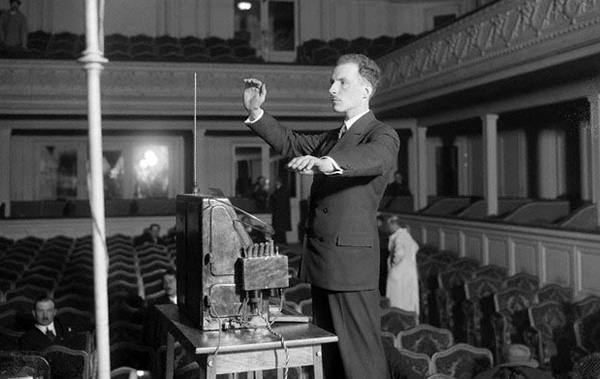
Going down the steps into the cellar of the Red Shop at Winzavod, we first learn that it is not the academically educated composers who were the pioneers of revolutionary music technologies, but rather representatives of affiliated professions: artists, actors, film directors and poets. Musician Lev Termen (Leon Theremin) studied physics and mathematics, physicist and mathematician Pavel Leyberg was interested in the theory of music; artist Boris Yankovsky was mastering elementary acoustics and created new sound synthesis and transformation techniques.
Yet these super-advanced multi-professionals had very little time: fast-growing censorship, the phasing out avant-garde research and repressions closed the curtain on experimentalism by the late 1930s.
A good example is the most well-known invention which, leaving the experimental domain, long ago staked an exceptional place among the modern instruments – the thereminvox. On display at the exposition is one of such thereminvoxes assembled by Lev Termen in a Magadan camp, at the Tupolev design bureau CDB-29. Incidentally, a direct assistant of Termen in the famous mickey-mouse outfit was Sergey Korolev, later the famous designer of spacecraft.
In parallel with ongoing work on acoustic devices, the convict inventors developed prototypes of cruise missiles as well as the unique eavesdropping system Buran, for which Termen was later honored with Stalin’s award. There was awards ceremony, since the people’s enemy had to stay several more years behind bars on false allegations. The more surrealistic the situation, the more incredible the inventions…
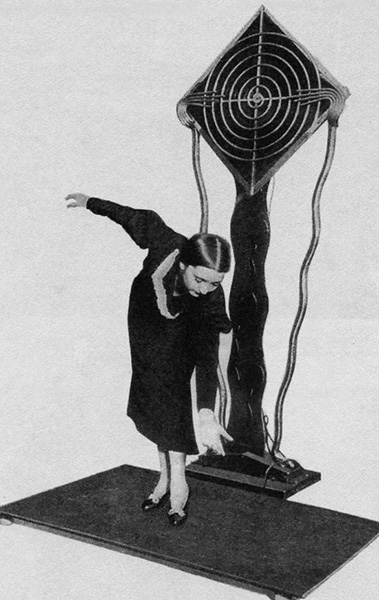
Apart from several types of thereminvoxes, on display at the exposition were other inventions of the genius – the less known harmonium, rythmicon that was actually the first rhythm machine, and terpsitone. The latter represents a small wooden platform where you need to move and hop in order to extract the sound.
Dancing on the terpsitone, it is possible to derive absolutely amazing sound effects. Visitors to the exposition apparently enjoy managing the terpsitone, since the interactive device allows the mover to become part of a musical installation. Using modern-day software, the terpsitone and the thereminvox have become perfect means of creating interactive art of some sort. Is it worth mentioning that the thereminvox that became the first electronic musical instrument in history was invented in the revolutionary Moscow in 1919?
Revolutionary experiment
All experimenters, even those who proposed seemingly crazy ideas, could count on the support of the fledgling Soviet power.
Founded in Moscow in 1921 was the State Institute of Musical Culture (SIMC) that united under its roof workers of culture engaged in acoustics, musical studies, ethnic musicology, psychology and physiology as well as in creating novel musical instruments.
The sound is a wave having a certain form. Several leading specialists of the SIMC came up with the idea that if the sound can leave a visual imprint, why not repositioning these items and drawing the sound independently? This was already a direct path to creating the first synthesizer or electronic keyboard.
There were several synthesizer prototypes created in the Soviet Union that performed such artificially created soundtracks. Among them is the variophone of Yevgeny Sholpo – this instrument allowed arbitrary changing of the pitch, producing glissando, vibrato, shades, changing the sound volume and building polyphonic chords and harmonies. Using the variophone, a significant number of films were dubbed and a large number of artificial soundtracks were created, including Carburetor Suite by Georgy Rimsky-Korsakov (1933), Waltz by N. Timofeev (composer of the Enthusiasm film by D. Vetrov), R. Wagner’s Flight of the Valkyries, The Sixth Rhapsody by Liszt, and others.
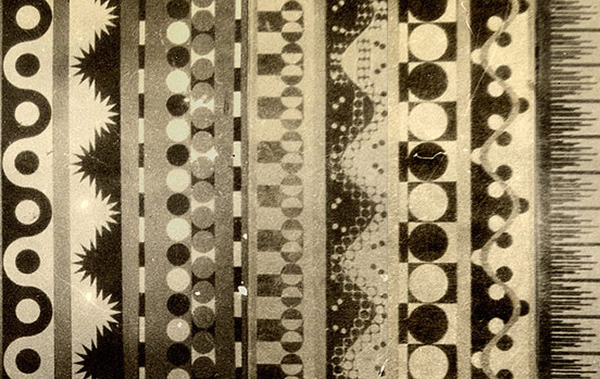
A bit less known is Andrei Volodin’s “Ekvodin” which, unfortunately, was not included in the exposition for the lack of an air-conditioner in the premises. “Like all other unique Soviet engineering developments in electronic music, Ekvodin was buried in the swamp of Soviet economy of the 1960s,” Andrei Smirnov noted with regret.
This is also how a unique preset synthesizer, with more than 600 sounds programmed, that was honored with the gold medal at the international trade fair Expo-58 in Brussels, sank into oblivion.
A happier lot fell to the share of another invention going back to 1931: a system of sound mechanical recording on the 35-mm needle Shorinophone. Its creator Alexander Shorin was honored with Stalin’s Award of the first degree. Recorded on the Shorinophone were both the signals of R-05 missiles and soundtracks of the first in the USSR dubbed films: Road to Life and Jolly Fellows.
City as orchestra
Another inventor as State Institute of Musical Culture was avant-garde musician Arseny Avraamov. He deserves a special mention, as an entire hall was devoted to him and his ideas at the exposition. His most famous brainchild is “The Symphony of Honks” that was performed twice in the early 1920s, first in Baku and then in Moscow.
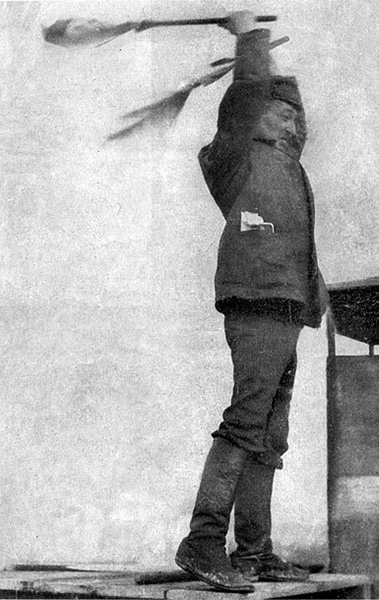
Just imagine a grand-scale action involving the whole city: the engines of hydroplanes, the hoots of factories and plants, the whistles of ships and steam engines and two artillery squads performing the role of percussions. The conductor, Avraamov himself, was standing on a special tower and guiding the concert using color flags and gun shots. The central sound machine, named “Magistral” by the author, comprised 50 engine whistles managed a group of musicians using “textual music”.
They played revolutionary songs, to be sure: International and La Marseillaise.
Nevertheless, this was an experiment and everything wasn’t quite smooth, and certainly far from everybody was delighted. “Breaking loose from the intonation material accumulated by advanced musical culture, prejudiced renunciation of the means of musical expression, developed throughout the history of music, and ignoring traditional musical instruments – all those failures did not allow Avraamov to reach his end: to express the revolutionary hopes and emotions of people’s masses,” said one of the Soviet newspapers, describing his performance in Moscow on November 7, 1923.
People were carried away with bold experiments and there could be no talk of reconciliation. How could Avraamov come to terms with any traditional musician, if he considered Bach “the greatest culprit of history, who slowed by two centuries the logical evolution of sound contemplation and impaired the hearing of millions”? In the 1920s he even submitted to Lunacharsky for consideration proposal to burn all grand pianos as a symbol of the 12-stage keyboard tuning, he so vehemently despised. This proposal was not supported, to be sure, and Avraamov invented his own microchromatic scheme, having placed 48 microtones in his octave.
However, Avraamov was certainly supported by many of his colleagues, including Georgy Rimsky-Korsakov, a grandson of the great composer, the author of The Maid of Pskov and The Golden Cockerel. Georgy participated in the creation of the variophone and was widely known among a small circle of elite composers – the inventors of microtone systems.
The era of synthesized sound
A modest but conspicuous place at the exposition is given to Western inventors. Andrei Smirnov, compiling the exposition, drew a very delicate parallel between Russia and the West. Of course, the exhibition of this scale could not go without the legendary synthesizer Moogtonium, or simply the Moog. Its creators Bob Moog and Max Brand built the first modular synthesizer in the late 1960s, much later than most of the exhibits, and yet it is explicitly linked with them philosophically.
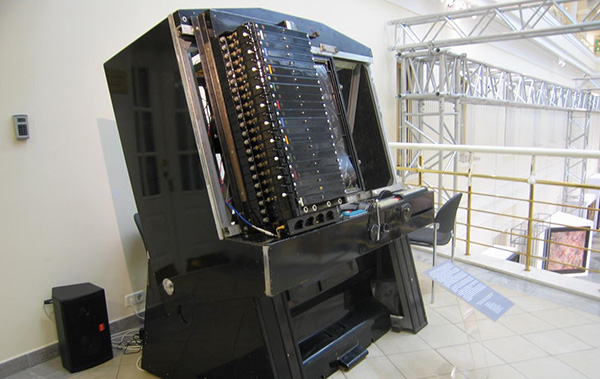
The legendary ANS synthesizer of Yevgeny Murzin, thought to be the world’s first polyphonic synthesizer, served as a bridge between synthesizer prototypes and later Western versions. In particular, it was used to create the theme of Tarkovsky’s
Solaris, and many Soviet avant-garde composers used it for their experiments – for instance, Edison Denisov, Alfred Schnittke, Sofia Gubaydullina, and others. Although Murzin was awarded the patent for the ANS (the initials of the Russian composer Alexander Nikolaevich Scriabin) only in 1959, and people of music began widely using this instrument only towards the late 1960s, although he had made the first version back in the late 1930s.
A century later, at the site of the Moscow Plant of Grape and Dessert Wines (today’s Winzavod Centre for Contemporary Art), in the hall with futuristic brontosaurs of the synthesizer era, people examine visual score patterns and listen in earphones to the music they never encountered before and which they may never hear again. The color music which was the idée fixe of Mr. Scriabin was put into practice in several original attempts to create unique sound synthesizing instruments. “Music lives by thoughts,” Alexander Scriabin once said. Let’s hope that all who share opinion have the opportunity to visit the Pioneers of the Sound exhibition, which is open until February 1.
Anna Genova

 Going down the steps into the cellar of the Red Shop at Winzavod, we first learn that it is not the academically educated composers who were the pioneers of revolutionary music technologies, but rather representatives of affiliated professions: artists, actors, film directors and poets. Musician Lev Termen (Leon Theremin) studied physics and mathematics, physicist and mathematician Pavel Leyberg was interested in the theory of music; artist Boris Yankovsky was mastering elementary acoustics and created new sound synthesis and transformation techniques.
Going down the steps into the cellar of the Red Shop at Winzavod, we first learn that it is not the academically educated composers who were the pioneers of revolutionary music technologies, but rather representatives of affiliated professions: artists, actors, film directors and poets. Musician Lev Termen (Leon Theremin) studied physics and mathematics, physicist and mathematician Pavel Leyberg was interested in the theory of music; artist Boris Yankovsky was mastering elementary acoustics and created new sound synthesis and transformation techniques. Apart from several types of thereminvoxes, on display at the exposition were other inventions of the genius – the less known harmonium, rythmicon that was actually the first rhythm machine, and terpsitone. The latter represents a small wooden platform where you need to move and hop in order to extract the sound.
Apart from several types of thereminvoxes, on display at the exposition were other inventions of the genius – the less known harmonium, rythmicon that was actually the first rhythm machine, and terpsitone. The latter represents a small wooden platform where you need to move and hop in order to extract the sound. A bit less known is Andrei Volodin’s “Ekvodin” which, unfortunately, was not included in the exposition for the lack of an air-conditioner in the premises. “Like all other unique Soviet engineering developments in electronic music, Ekvodin was buried in the swamp of Soviet economy of the 1960s,” Andrei Smirnov noted with regret.
A bit less known is Andrei Volodin’s “Ekvodin” which, unfortunately, was not included in the exposition for the lack of an air-conditioner in the premises. “Like all other unique Soviet engineering developments in electronic music, Ekvodin was buried in the swamp of Soviet economy of the 1960s,” Andrei Smirnov noted with regret. Just imagine a grand-scale action involving the whole city: the engines of hydroplanes, the hoots of factories and plants, the whistles of ships and steam engines and two artillery squads performing the role of percussions. The conductor, Avraamov himself, was standing on a special tower and guiding the concert using color flags and gun shots. The central sound machine, named “Magistral” by the author, comprised 50 engine whistles managed a group of musicians using “textual music”.
Just imagine a grand-scale action involving the whole city: the engines of hydroplanes, the hoots of factories and plants, the whistles of ships and steam engines and two artillery squads performing the role of percussions. The conductor, Avraamov himself, was standing on a special tower and guiding the concert using color flags and gun shots. The central sound machine, named “Magistral” by the author, comprised 50 engine whistles managed a group of musicians using “textual music”.





